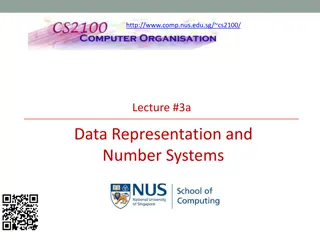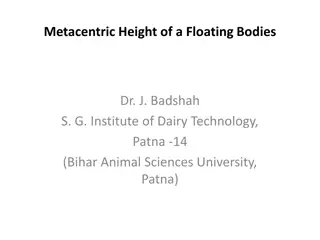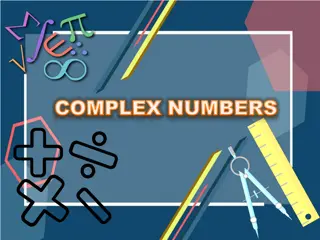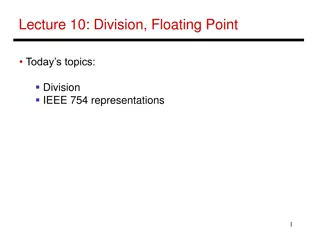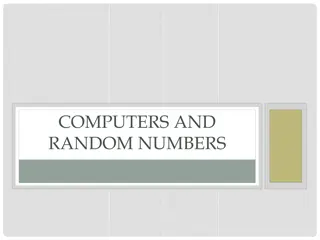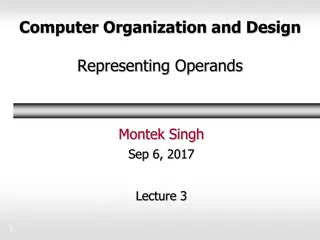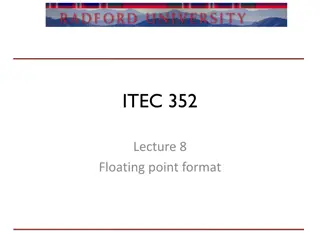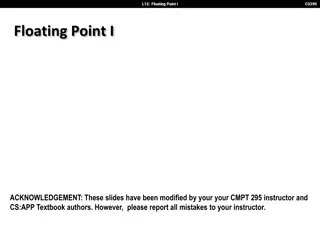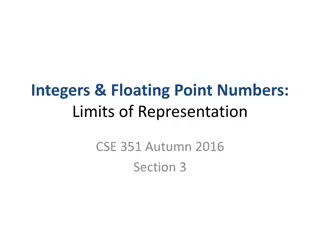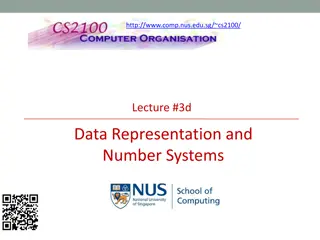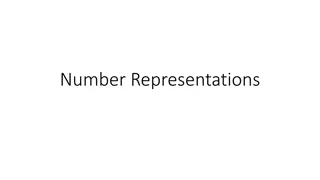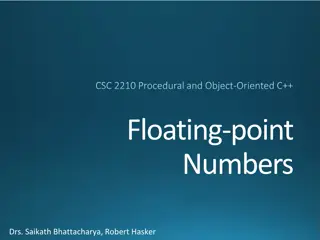Understanding Floating Point Representation of Numbers
Floating point representation is crucial in computer arithmetic operations. It involves expressing real numbers as a mantissa and an exponent to preserve significant digits and increase the range of values stored. This normalized floating point mode allows for efficient storage and manipulation of real numbers in computers. Unlike fixed point arithmetic, floating point arithmetic offers a more versatile and practical way of handling real numbers in computing systems.
Download Presentation

Please find below an Image/Link to download the presentation.
The content on the website is provided AS IS for your information and personal use only. It may not be sold, licensed, or shared on other websites without obtaining consent from the author. Download presentation by click this link. If you encounter any issues during the download, it is possible that the publisher has removed the file from their server.
E N D
Presentation Transcript
Floating Point Representation of Numbers Farah Sharmin Senior Lecturer Department of CSE Daffodil International University
References Fundamentals of Computers by V. Rajaraman and N. Adabala, 6th Edition. [Chapter 6] 2
Types of Computer Arithmetic There are two types of arithmetic operations which are required in computers. These are: (i) Integer arithmetic, (ii) Real or floating point arithmetic. Integer arithmetic, as the name implies, deals with integer operands, that is, operands without fractional parts. Real arithmetic, on the other hand, uses numbers with fractional parts and is used in most computations. 3
Fixed Point Arithmetic One method of representing real numbers in a computer would be by assuming a fixed position for the binary point and storing numbers with an assumed decimal point, as shown in the following figure. This +101101101.101101. figure shows a memory location storing 4
Fixed Point Arithmetic... If such a convention is used, the maximum and minimum (in magnitude) numbers that may be stored are: 111111111.1111112 = (29 - 1) + (1 - 2-6) (Maximum) = 511.98437510 000000000.0000012 = 2-6 (Minimum) = 0.01562510 This range is quite inadequate in practice and therefore a different convention for representing real numbers is adopted. 5
Floating Point Arithmetic This convention aims at preserving the maximum number of significant digits in a real number and increasing the range of values of real numbers stored. This representation is called the normalized floating point mode of representing and storing real numbers. In this mode, a real number is expressed as a combination of a mantissa and an exponent. The mantissa is made less than 1 and greater than or equal to 0.1, and the exponent is the power of 2 which multiplies the mantissa. 6
Floating Point Arithmetic ... For example, the number 1011.0101 x 27 is represented in this notation as 0.10110101 x 211 = 0.10110101E01011 The mantissa is 0.10110101 and the exponent 1011. The number is stored in normalized floating point mode as shown in the figure in the next slide. 7
Floating Point Arithmetic ... In the representation of the above figure, the 16 bits are divided into two parts. 9 bits are used for the mantissa and 7 bits for the exponent. The mantissa and exponent have their own independent signs. 8
Floating Point Arithmetic ... While storing numbers, the leading bit in the mantissa is always made non-zero by appropriately shifting it and adjusting the value of the exponent. Thus the number 0.000010101 would be stored as shown in the following figure. 9
Floating Point Arithmetic ... The shifting of the mantissa to the left till its most significant bit is non-zero is called normalization. The normalization is done to preserve the maximum number of useful (information carrying) bits. The leading zeros in 0.000010101 serve only to locate the binary point. The information may thus be transferred to the exponent part of the number and the number is stored as 0.10101 x 2-4. 10
Floating Point Arithmetic ... When numbers are stored using this notation, the range of numbers (magnitude) that may be stored will be: Maximum = 0.11111111E0111111 = (1 2 8) x 226 1 263 Minimum = 0.10000000E1111111 = 2 1 x 2 (26 1) = 2 64 This range is much larger than the range 29 to 2-6 obtained with the fixed point representation. 11
Key Words/Phrases Integer arithmetic Real or floating point arithmetic normalized floating point mode Mantissa Exponent most significant bit Normalization


